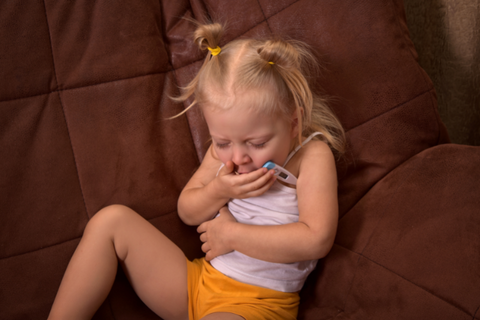Guest Post by Katy Fleming, MA, LPC, BSN, RN
As a parent, it’s frightening to hear your child wheeze. Certain breath sounds indicate serious acute conditions, however, it’s more common than you may realize. Studies indicate that approximately 30-50% of children experience an episode of wheezing by the age of 6.
Let’s define wheezing and break down the essential facts for parents of young children.

What Parents Need to Know About Wheezing
Wheezing is a high-pitched breath sound typically heard on exhale. It may have a whistling sound and is heard when listening to the lungs. You most likely will hear your child or baby wheeze, however, there may be times when it’s only heard through a stethoscope.
Listed below are some common causes of wheezing and further education on breath sounds from your child.
Typical Causes of Wheezing
After hearing their child wheeze, many parents first assume their child is struggling with asthma. However, there are several possible causes and age plays a factor in the diagnosis process.
1. Respiratory Infections
Younger children and infants commonly wheeze when experiencing a respiratory infection such as bronchiolitis. Bronchiolitis is typically caused by respiratory syncytial virus (RSV) and is an infection of the lungs. In addition to wheezing, children with bronchiolitis typically suffer from coughing, a runny nose, and a low-grade fever.
2. Allergies
Your infant isn’t able to blow their nose or express their needs to you. So, they may build up more phlegm and create blockage in their airway. Young children and infants may develop allergies when exposed to dust or air pollution.
3. Asthma
Older children that continually struggle with episodes of wheezing may require diagnostic testing for asthma. Approximately 1 in every 12 children in the US has asthma. Children with parents who have asthma and children exposed to second-hand cigarette smoke are more likely to develop the condition.
If testing determines that your child has asthma, then the pediatrician may prescribe inhaled corticosteroids. Symptoms of asthma also include coughing and shortness of breath, which tend to worsen at night.

4. Gastroesophageal Reflux Disease (GERD)
Very common among children under 3, Gastroesophageal reflux disease occurs when stomach acid leaks into the esophagus. This can irritate and damage the esophageal lining. In GERD, stomach acid moves into the lungs causing irritation and wheezing.
It’s certainly common for infants to spit up, however, your child may suffer from GERD if they also have difficulty swallowing, losing weight, and wheezing.
Wheezing Vs Stridor
Wheezing and stridor are both high-pitched abnormal breath sounds. Wheezing is heard from the lungs and is more likely to occur when your child exhales. Stridor occurs in the upper airway when breathing in or out. Additionally, it’s a higher pitch than wheezing.
The most common cause of stridor is when a foreign object is stuck in the airway. Since children have smaller airways, they are more likely to experience stridor.
When Wheezing is an Emergency
It’s difficult to discern between different breath sounds in your child. If the wheezing is accompanied by other symptoms such as a runny nose and chest congestion, it’s more likely a virus.
If your child exhibits any of these symptoms, seek medical attention immediately:
- Sudden change in breathing or difficulty breathing
- Lips or skin turning blue
- Rapid breathing
- Wheezing begins after a bee sting
- Wheezing begins after eating an allergy-causing food

There are various other causes of wheezing including congenital conditions such as cystic fibrosis. These are less common, but a consideration if your child has exhibited wheezing since birth.
The only way to appropriately treat wheezing is to identify the cause. When evaluated, your child’s pediatrician will ask when the wheezing began and if any other symptoms were observed.
Avoiding second-hand smoke, increasing your child’s fluids, and utilizing a humidifier are a few ways to relieve wheezing related to viruses and other non-emergent causes.
If you want to learn more about your baby's breathing, download our FREE Baby Breathing basics eBook HERE.
If you enjoyed this article, you will also love:
- 5 Causes of Ear Pain
- Why Most Babies Can't Breathe Through Their Mouth
- 5 Common Child Health Myths Busted By a Pediatric ENT
- What Parents Need to Know About Croup
- Ear Infection Home Remedies
As a licensed counselor and registered nurse, Katy approaches freelance writing with years of experience and a unique perspective. Alongside her partner, Katy loves to travel the world and embrace other cultures from volcanoes in Iceland to villages in India.
The Nozebot is a battery-powered suction device designed to clear nasal congestion in babies and children.



